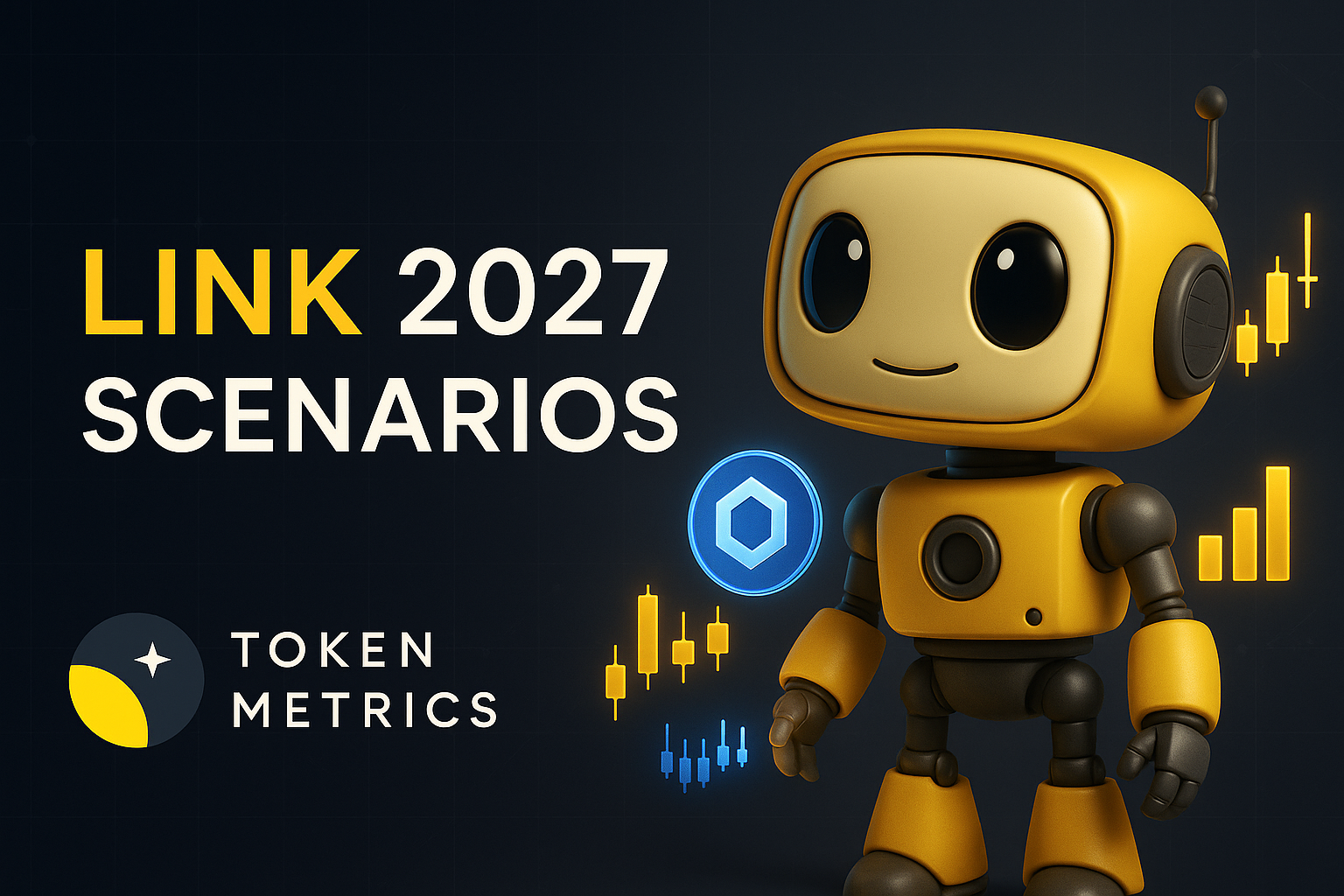Top Crypto Trading Platforms in 2025







%201.svg)
%201.svg)
Big news: We’re cranking up the heat on AI-driven crypto analytics with the launch of the Token Metrics API and our official SDK (Software Development Kit). This isn’t just an upgrade – it's a quantum leap, giving traders, hedge funds, developers, and institutions direct access to cutting-edge market intelligence, trading signals, and predictive analytics.
Crypto markets move fast, and having real-time, AI-powered insights can be the difference between catching the next big trend or getting left behind. Until now, traders and quants have been wrestling with scattered data, delayed reporting, and a lack of truly predictive analytics. Not anymore.
The Token Metrics API delivers 32+ high-performance endpoints packed with powerful AI-driven insights right into your lap, including:
Getting started with the Token Metrics API is simple:
At Token Metrics, we believe data should be decentralized, predictive, and actionable.
The Token Metrics API & SDK bring next-gen AI-powered crypto intelligence to anyone looking to trade smarter, build better, and stay ahead of the curve. With our official SDK, developers can plug these insights into their own trading bots, dashboards, and research tools – no need to reinvent the wheel.
%201.svg)
%201.svg)
Infrastructure protocols become more valuable as the crypto ecosystem scales and relies on robust middleware. Chainlink provides critical oracle infrastructure where proven utility and deep integrations drive long-term value over retail speculation. Increasing institutional adoption raises demand for professional-grade data delivery and security.
Token Metrics projections for LINK below span multiple total market cap scenarios from conservative to aggressive. Each tier assumes different levels of infrastructure demand as crypto evolves from speculative markets to institutional-grade systems. These bands frame LINK's potential outcomes into 2027.

Disclosure
Educational purposes only, not financial advice. Crypto is volatile, do your own research and manage risk.
How to read it: Each band blends cycle analogues and market-cap share math with TA guardrails. Base assumes steady adoption and neutral or positive macro. Moon layers in a liquidity boom. Bear assumes muted flows and tighter liquidity.
TM Agent baseline: Token Metrics lead metric for Chainlink, cashtag $LINK, is a TM Grade of 23.31%, which translates to a Sell, and the trading signal is bearish, indicating short-term downward momentum. This means Token Metrics currently does not endorse $LINK as a long-term buy at current conditions.
Live details: Chainlink Token Details
Affiliate Disclosure: We may earn a commission from qualifying purchases made via this link, at no extra cost to you.
Token Metrics scenarios span four market cap tiers, each representing different levels of crypto market maturity and liquidity:
8T: At an 8 trillion dollar total crypto market cap, LINK projects to $26.10 in bear conditions, $30.65 in the base case, and $35.20 in bullish scenarios.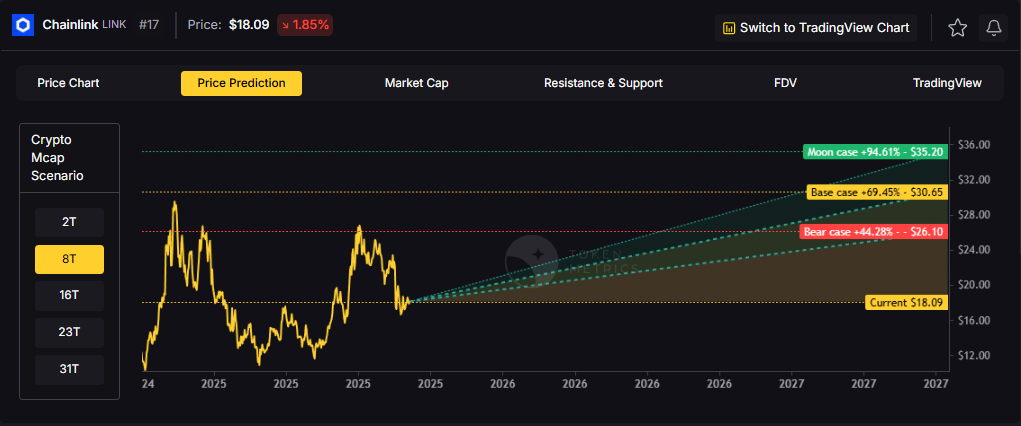
16T: Doubling the market to 16 trillion expands the range to $42.64 (bear), $56.29 (base), and $69.95 (moon).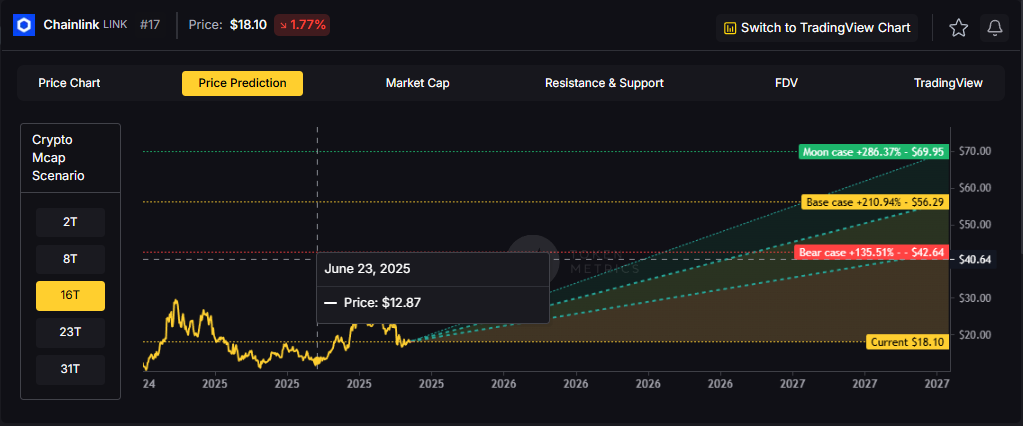
23T: At 23 trillion, the scenarios show $59.18, $81.94, and $104.70 respectively.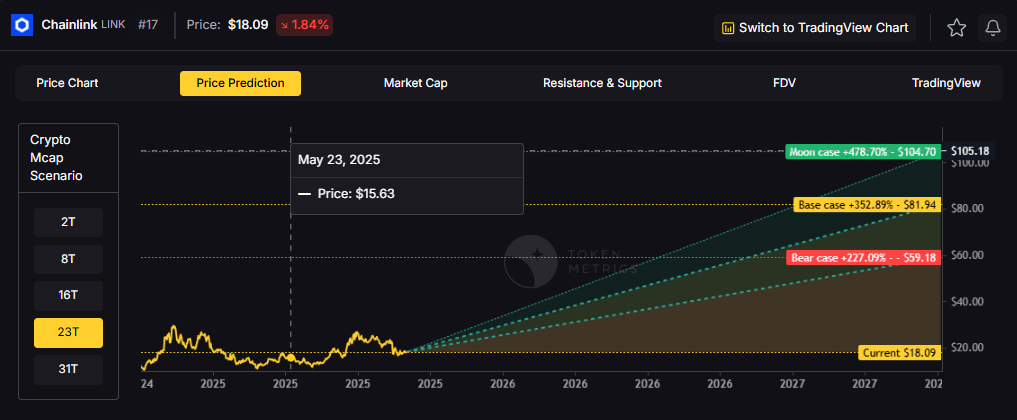
31T: In the maximum liquidity scenario of 31 trillion, LINK could reach $75.71 (bear), $107.58 (base), or $139.44 (moon).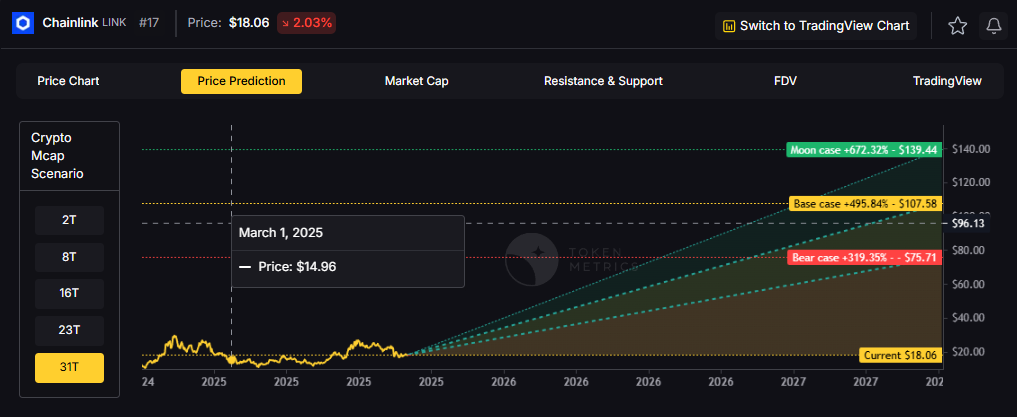
Chainlink represents one opportunity among hundreds in crypto markets. Token Metrics Indices bundle LINK with top one hundred assets for systematic exposure to the strongest projects. Single tokens face idiosyncratic risks that diversified baskets mitigate.
Historical index performance demonstrates the value of systematic diversification versus concentrated positions.
Chainlink is a decentralized oracle network that connects smart contracts to real-world data and systems. It enables secure retrieval and verification of off-chain information, supports computation, and integrates across multiple blockchains. As adoption grows, Chainlink serves as critical infrastructure for reliable data feeds and automation.
The LINK token is used to pay node operators and secure the network’s services. Common use cases include DeFi price feeds, insurance, and enterprise integrations, with CCIP extending cross-chain messaging and token transfers.
Vision: Chainlink aims to create a decentralized, secure, and reliable network for connecting smart contracts with real-world data and systems. Its vision is to become the standard for how blockchains interact with external environments, enabling trust-minimized automation across industries.
Problem: Smart contracts cannot natively access data outside their blockchain, limiting their functionality. Relying on centralized oracles introduces single points of failure and undermines the security and decentralization of blockchain applications. This creates a critical need for a trustless, tamper-proof way to bring real-world information onto blockchains.
Solution: Chainlink solves this by operating a decentralized network of node operators that fetch, aggregate, and deliver data from off-chain sources to smart contracts. It uses cryptographic proofs, reputation systems, and economic incentives to ensure data integrity. The network supports various data types and computation tasks, allowing developers to build complex, data-driven decentralized applications.
Market Analysis: Chainlink is a market leader in the oracle space and a key infrastructure component in the broader blockchain ecosystem, particularly within Ethereum and other smart contract platforms. It faces competition from emerging oracle networks like Band Protocol and API3, but maintains a strong first-mover advantage and widespread integration across DeFi, NFTs, and enterprise blockchain solutions. Adoption is driven by developer activity, partnerships with major blockchain projects, and demand for secure data feeds. Key risks include technological shifts, regulatory scrutiny on data providers, and execution challenges in scaling decentralized oracle networks. As smart contract usage grows, so does the potential for oracle services, positioning Chainlink at the center of a critical niche, though its success depends on maintaining security and decentralization over time.
Fundamental Grade: 74.58% (Community 81%, Tokenomics 100%, Exchange 100%, VC —, DeFi Scanner 17%).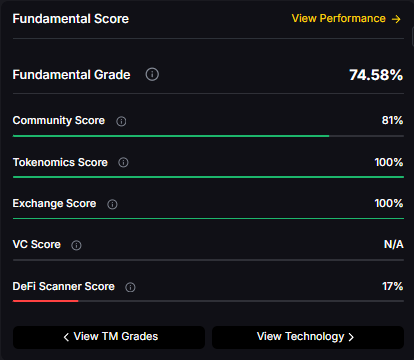
Technology Grade: 88.50% (Activity 81%, Repository 72%, Collaboration 100%, Security 86%, DeFi Scanner 17%).
Can LINK reach $100?
Yes. Based on the scenarios, LINK could reach $100+ in the 23T moon case. The 23T tier projects $104.70 in the moon case. Not financial advice.
What price could LINK reach in the moon case?
Moon case projections range from $35.20 at 8T to $139.44 at 31T. These scenarios assume maximum liquidity expansion and strong Chainlink adoption. Not financial advice.
Should I buy LINK now or wait?
Timing depends on risk tolerance and macro outlook. Current price of $18.09 sits below the 8T bear case in the scenarios. Dollar-cost averaging may reduce timing risk. Not financial advice.
Track live grades and signals: Token Details
Want exposure? Buy LINK on MEXC
Disclosure
Educational purposes only, not financial advice. Crypto is volatile, do your own research and manage risk.
Discover the full potential of your crypto research and portfolio management with Token Metrics. Our ratings combine AI-driven analytics, on-chain data, and decades of investing expertise—giving you the edge to navigate fast-changing markets. Try our platform to access scenario-based price targets, token grades, indices, and more for institutional and individual investors. Token Metrics is your research partner through every crypto market cycle.
%201.svg)
%201.svg)
The crypto market is tilting bullish into 2026 as liquidity, infrastructure, and participation improve across the board. Clearer rules and standards are reshaping the classic four-year cycle, flows can arrive earlier, and strength can persist longer than in prior expansions.
Institutional access is widening through ETFs and custody, while L2 scaling and real-world integrations help sustain on‑chain activity. This healthier backdrop frames our scenario work for HYPE. The ranges below reflect different total crypto market sizes and the share Hyperliquid could capture under each regime.
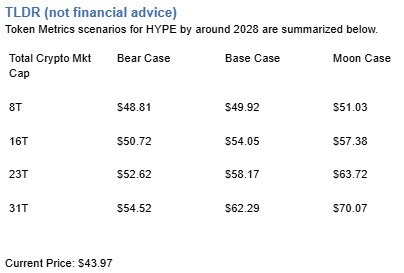
Disclosure
Educational purposes only, not financial advice. Crypto is volatile, do your own research and manage risk.
How to read it: Each band blends cycle analogues and market-cap share math with TA guardrails. Base assumes steady adoption and neutral or positive macro. Moon layers in a liquidity boom. Bear assumes muted flows and tighter liquidity.
TM Agent baseline: Token Metrics TM Grade is 73.9%, a Buy, and the trading signal is bearish, indicating short-term downward momentum. This means Token Metrics judges HYPE as fundamentally attractive over the long term, while near-term momentum is negative and may limit rallies.
Live details: Hyperliquid Token Details
Affiliate Disclosure: We may earn a commission from qualifying purchases made via this link, at no extra cost to you.
Scenario Analysis
Token Metrics scenarios span four market cap tiers, each representing different levels of crypto market maturity and liquidity:
8T: At an 8 trillion dollar total crypto market cap, HYPE projects to $48.81 in bear conditions, $49.92 in the base case, and $51.03 in bullish scenarios.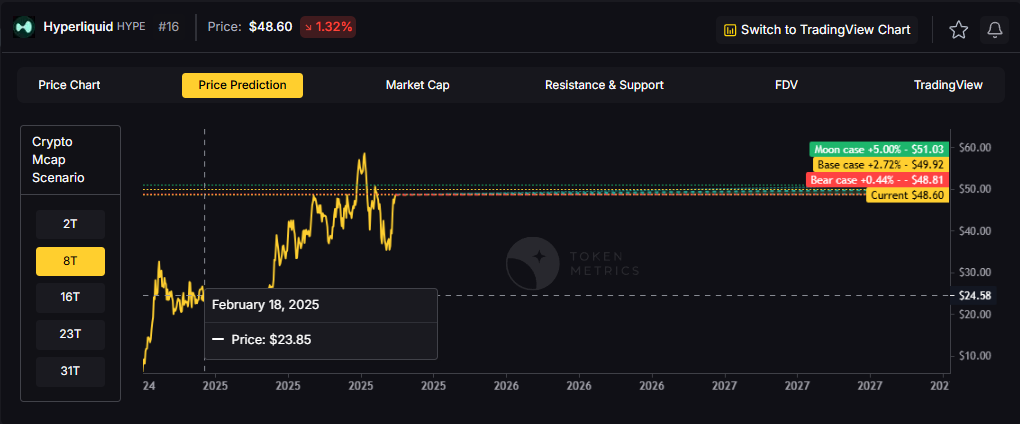
16T: Doubling the market to 16 trillion expands the range to $50.72 (bear), $54.05 (base), and $57.38 (moon).
23T: At 23 trillion, the scenarios show $52.62, $58.17, and $63.72 respectively.
31T: In the maximum liquidity scenario of 31 trillion, HYPE could reach $54.52 (bear), $62.29 (base), or $70.07 (moon).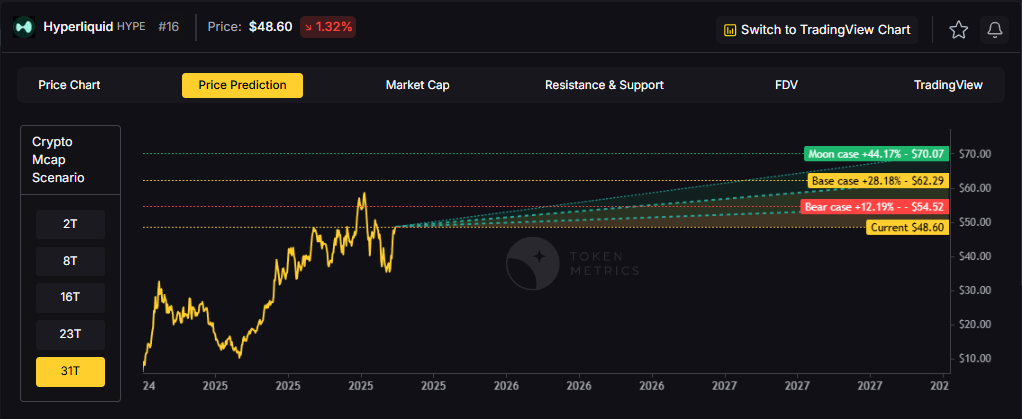
Each tier assumes progressively stronger market conditions, with the base case reflecting steady growth and the moon case requiring sustained bull market dynamics.
Diversification matters. HYPE is compelling, yet concentrated bets can be volatile. Token Metrics Indices hold HYPE alongside the top one hundred tokens for broad exposure to leaders and emerging winners.
Our backtests indicate that owning the full market with diversified indices has historically outperformed both the total market and Bitcoin in many regimes due to diversification and rotation.
Hyperliquid is a decentralized exchange focused on perpetual futures with a high-performance order book architecture. The project emphasizes low-latency trading, risk controls, and capital efficiency aimed at professional and retail derivatives traders. Its token, HYPE, is used for ecosystem incentives and governance-related utilities.
Can HYPE reach $60?
Yes, the 23T and 31T tiers imply ranges above $60 in the Base and Moon bands, though outcomes depend on liquidity and adoption. Not financial advice.
Is HYPE a good long-term investment?
Outcome depends on adoption, liquidity regime, competition, and supply dynamics. Diversify and size positions responsibly.
Disclosure
Educational purposes only, not financial advice. Crypto is volatile, do your own research and manage risk.
Token Metrics delivers AI-based crypto ratings, scenario projections, and portfolio tools so you can make smarter decisions. Discover real-time analytics on Token Metrics.
%201.svg)
%201.svg)
The Layer 1 competitive landscape is consolidating as markets recognize that specialization matters more than being a generic "Ethereum killer." Cardano positions itself in this multi-chain world with specific technical and ecosystem advantages. Infrastructure maturity around custody, bridges, and developer tools makes alternative L1s more accessible heading into 2026.
The scenario projections below map different market share outcomes for ADA across varying total crypto market sizes. Base cases assume Cardano maintains current ecosystem momentum, while moon scenarios factor in accelerated adoption and bear cases reflect increased competitive pressure.

Disclosure
Educational purposes only, not financial advice. Crypto is volatile, do your own research and manage risk.
How to read it: Each band blends cycle analogues and market-cap share math with TA guardrails. Base assumes steady adoption and neutral or positive macro. Moon layers in a liquidity boom. Bear assumes muted flows and tighter liquidity.
TM Agent baseline: Token Metrics lead metric for Cardano, cashtag $ADA, is a TM Grade of 29.72%, which translates to a Sell, and the trading signal is bearish, indicating short-term downward momentum. This combination means Token Metrics does not currently endorse $ADA as a long-term buy at current levels. A brief market context: Bitcoin's direction remains the dominant macro driver for smart contract platforms, so sustained upside for $ADA would require a broader crypto risk-on regime and improving fundamentals or developer activity for Cardano.
Live details: Cardano Token Details
Affiliate Disclosure: We may earn a commission from qualifying purchases made via this link, at no extra cost to you.
Token Metrics scenarios span four market cap tiers, each representing different levels of crypto market maturity and liquidity:




Each tier assumes progressively stronger market conditions, with the base case reflecting steady growth and the moon case requiring sustained bull market dynamics.
Cardano represents one opportunity among hundreds in crypto markets. Token Metrics Indices bundle ADA with top one hundred assets for systematic exposure to the strongest projects. Single tokens face idiosyncratic risks that diversified baskets mitigate.
Historical index performance demonstrates the value of systematic diversification versus concentrated positions.
Cardano is a blockchain platform designed to support secure, scalable, and sustainable decentralized applications and smart contracts. It is known for its research-driven development approach, emphasizing peer-reviewed academic research and formal verification methods to ensure reliability and security. As a proof-of-stake Layer 1 blockchain, Cardano aims to offer energy efficiency and long-term scalability, positioning itself as a competitor to platforms like Ethereum. Its native token, ADA, is used for transactions, staking, and governance. Adoption is driven by technological rigor and ecosystem growth, though progress has been criticized for being slow compared to more agile competitors. Risks include execution delays, competition, and market volatility.
Cardano’s vision is to create a decentralized platform that enables sustainable and inclusive economic systems through advanced cryptography and scientific methodology. It aims to bridge gaps between traditional financial systems and blockchain technology, promoting accessibility and security for users globally.
Token Metrics AI provides comprehensive context on Cardano's positioning and challenges.


Can ADA reach $4?
Based on the scenarios, ADA could reach $4 in the 31T moon case. The 31T tier projects $4.27 in the moon case. Not financial advice.
Can ADA 10x from current levels?
At current price of $0.65, a 10x would reach $6.50. This falls within none of the provided scenarios, which top out at $4.27 in the 31T moon case. Bear in mind that 10x returns require substantial market cap expansion. Not financial advice.
What price could ADA reach in the moon case?
Moon case projections range from $1.16 at 8T to $4.27 at 31T. These scenarios assume maximum liquidity expansion and strong Cardano adoption. Not financial advice.
Disclosure
Educational purposes only, not financial advice. Crypto is volatile, do your own research and manage risk.

%201.svg)
%201.svg)
REST APIs are the lingua franca of modern web and data ecosystems. Developers, data scientists, and product teams rely on RESTful endpoints to move structured data between services, power mobile apps, and connect AI models to live data sources. This post explains what REST APIs are, the core principles and methods, practical design patterns, security considerations, and how to evaluate REST APIs for use in crypto and AI workflows.
Representational State Transfer (REST) is an architectural style for distributed systems. A REST API exposes resources—such as users, orders, or market ticks—via predictable URLs and HTTP methods. Each resource representation is typically transferred in JSON, XML, or other media types. The API defines endpoints, input and output schemas, and expected status codes so clients can programmatically interact with a server.
Key characteristics include stateless requests, cacheable responses when appropriate, uniform interfaces, and resource-oriented URIs. REST is not a protocol but a set of conventions that favor simplicity, scalability, and composability. These properties make REST APIs well-suited for microservices, web clients, and integrations with analytics or machine learning pipelines.
Understanding the mapping between REST semantics and HTTP verbs is foundational:
Designing clear resource names and predictable query parameters improves developer experience. Use nouns for endpoints (e.g., /api/v1/orders) and separate filtering, sorting, and pagination parameters. Well-structured response envelopes with consistent error codes and time stamps help automation and observability.
Good REST API design balances usability, performance, and security. Start with a contract-first approach: define OpenAPI/Swagger schemas that describe endpoints, request/response shapes, authentication, and error responses. Contracts enable auto-generated clients, mock servers, and validation tooling.
Security considerations include:
Operational best practices include logging structured events, exposing health and metrics endpoints, and versioning APIs (e.g., v1, v2) to enable backward-compatible evolution. Use semantic versioning in client libraries and deprecate endpoints with clear timelines and migration guides.
Testing a REST API includes unit tests for business logic, contract tests against OpenAPI definitions, and end-to-end integration tests. Performance profiling should focus on latency tail behavior, not just averages. Key tools and techniques:
For AI systems, robust APIs must address reproducibility: include schema versioning and event timestamps so models can be retrained with consistent historical data. For crypto-related systems, ensure on-chain data sources and price oracles expose deterministic endpoints and clearly document freshness guarantees.
REST APIs are frequently used to expose market data, on-chain metrics, historical time-series, and signals that feed AI models or dashboards. When integrating third-party APIs for crypto data, evaluate latency, update frequency, and the provider's methodology for derived metrics. Consider fallbacks and reconciliations: multiple independent endpoints can be polled and compared to detect anomalies or outages.
AI agents often consume REST endpoints for feature extraction and live inference. Design APIs with predictable rate limits and batching endpoints to reduce overhead. Document data lineage: indicate when data is fetched, normalized, or transformed so model training and validation remain auditable.
Tools that combine real-time prices, on-chain insights, and signal generation can accelerate prototyping of analytics and agents. For example, Token Metrics provides AI-driven research and analytics that teams can evaluate as part of their data stack when building integrations.
Build Smarter Crypto Apps & AI Agents with Token Metrics
Token Metrics provides real-time prices, trading signals, and on-chain insights all from one powerful API. Grab a Free API Key
REST is an architectural style that leverages HTTP methods and resource-oriented URIs. It differs from RPC and SOAP by emphasizing uniform interfaces, statelessness, and resource representations. GraphQL is query-oriented and allows clients to request specific fields, which can reduce over-fetching but requires different server-side handling.
Use TLS for transport security, strong authentication (OAuth2, API keys, or mTLS), authorization checks on each endpoint, input validation, rate limiting, and monitoring. Consider short-lived tokens and revoke mechanisms for compromised credentials.
Adopt explicit versioning (path segments like /v1/), maintain backward compatibility when possible, and provide clear deprecation notices with migration guides. Use semantic versioning for client libraries and contract-first changes to minimize breaking updates.
Implement rate limits per API key or token, and communicate limits via headers (e.g., X-RateLimit-Remaining). Provide exponential backoff guidance for clients and consider burst allowances for intermittent workloads. Monitor usage patterns to adjust thresholds.
Essential practices include unit and contract tests, integration tests, load tests, structured logging, distributed tracing, and alerting on error rates or latency SLA breaches. Health checks and automated failover strategies improve availability.
This article is for educational and informational purposes only. It does not constitute investment, financial, or legal advice. Evaluate third-party tools and data sources independently and consider compliance requirements relevant to your jurisdiction and project.

%201.svg)
%201.svg)
REST APIs are the backbone of modern web services and integrations. Whether you are building internal microservices, public developer APIs, or AI-driven data pipelines, understanding REST principles, security models, and performance trade-offs helps you design maintainable and scalable systems.
REST (Representational State Transfer) is an architectural style that relies on stateless communication, uniform interfaces, and resource-oriented design. A REST API exposes resources—users, orders, metrics—via HTTP methods like GET, POST, PUT, PATCH, and DELETE. The simplicity of HTTP, combined with predictable URIs and standard response codes, makes REST APIs easy to adopt across languages and platforms. For teams focused on reliability and clear contracts, REST remains a pragmatic choice, especially when caching, intermediaries, and standard HTTP semantics are important.
Good REST design balances clarity, consistency, and flexibility. Key principles include:
Documenting these conventions—preferably with an OpenAPI/Swagger specification—reduces onboarding friction and supports automated client generation.
Security is non-negotiable. REST APIs commonly use bearer tokens (OAuth 2.0 style) or API keys for authentication, combined with TLS to protect data in transit. Important practices include:
For teams integrating sensitive data or financial endpoints, combining OAuth scopes, robust logging, and policy-driven access control improves operational security while keeping interfaces developer-friendly.
APIs must scale with usage. Optimize for common access patterns and reduce latency through caching, compression, and smart data modeling:
Design decisions should be driven by usage data: measure slow endpoints, understand paginated access patterns, and iterate on the API surface rather than prematurely optimizing obscure cases.
Test automation and telemetry are critical for API resilience. Build a testing pyramid with unit tests for handlers, integration tests for full request/response cycles, and contract tests against your OpenAPI specification. Observability—structured logs, request tracing, and metrics—helps diagnose production issues quickly.
AI-driven tools can accelerate design reviews and anomaly detection. For example, platforms that combine market and on-chain data with AI can ingest REST endpoints and provide signal enrichment or alerting for unusual patterns. When referencing such tools, ensure you evaluate their data sources, explainability, and privacy policies. See Token Metrics for an example of an AI-powered analytics platform used to surface insights from complex datasets.
Build Smarter Crypto Apps & AI Agents with Token Metrics
Token Metrics provides real-time prices, trading signals, and on-chain insights all from one powerful API. Grab a Free API Key
A REST API is an interface that exposes resources over HTTP using stateless requests and standardized methods. It emphasizes a uniform interface, predictable URIs, and leveraging HTTP semantics for behavior and error handling.
REST suits predictable, cacheable endpoints and simple request/response semantics. GraphQL can reduce over-fetching and allow flexible queries from clients. Consider developer experience, caching needs, and operational complexity when choosing between them.
Common approaches include URI versioning (e.g., /v1/) or header-based versioning. The key is to commit to a clear deprecation policy, document breaking changes, and provide migration paths for clients.
Use TLS for all traffic, issue scoped short-lived tokens, validate and sanitize inputs, impose rate limits, and log authentication events. Regular security reviews and dependency updates reduce exposure to known vulnerabilities.
OpenAPI/Swagger, Postman, and contract-testing frameworks allow automated validations. Observability stacks (Prometheus, Jaeger) and synthetic test suites help catch regressions and performance regressions early.
Disclaimer
This article is for educational and technical guidance only. It does not provide financial, legal, or investment advice. Evaluate tools, platforms, and architectural choices based on your organization’s requirements and compliance constraints.

%201.svg)
%201.svg)
REST API technology underpins much of today’s web, mobile, and AI-driven systems. Understanding REST fundamentals, design trade-offs, and operational patterns helps engineers build reliable integrations that scale, remain secure, and are easy to evolve. This article breaks down the core concepts, practical design patterns, and concrete steps to integrate REST APIs with AI and data platforms.
REST (Representational State Transfer) is an architectural style for distributed systems that uses standard HTTP methods to operate on resources. A REST API exposes resources—such as users, orders, or sensor readings—via predictable endpoints and leverages verbs like GET, POST, PUT, PATCH, and DELETE. Key characteristics include statelessness, resource-based URIs, and standardized status codes. These conventions make REST APIs easy to consume across languages, frameworks, and platforms.
Good REST API design balances clarity, stability, and flexibility. Consider these practical principles:
Document endpoints using OpenAPI/Swagger and provide sample requests/responses. Clear documentation reduces integration time and surface area for errors.
Security and observability are central to resilient APIs. Common patterns include:
Operational readiness often separates reliable APIs from fragile ones. Integrate logging and alerting into deployment pipelines and validate SLAs with synthetic checks.
APIs should be treated as products with release processes and compatibility guarantees. Recommended practices:
Following a disciplined lifecycle reduces friction for integrators and supports long-term maintainability.
REST APIs serve as the connective tissue between data sources and AI/analytics systems. Patterns to consider:
AI-driven research platforms and data providers expose REST APIs to make on-chain, market, and derived signals available to models. For example, AI-driven research tools such as Token Metrics provide structured outputs that can be integrated into feature stores and experimentation platforms.
Build Smarter Crypto Apps & AI Agents with Token Metrics
Token Metrics provides real-time prices, trading signals, and on-chain insights all from one powerful API. Grab a Free API Key
REST is an architectural style that uses HTTP and resource-oriented design. Alternatives include RPC-style APIs, GraphQL (which offers a single flexible query endpoint), and gRPC (binary, high-performance RPC). Choose based on latency, schema needs, and client diversity.
Use token-based authentication (OAuth2 client credentials or API keys), enforce TLS, implement scopes or claims to limit access, and rotate credentials periodically. Apply input validation, rate limits, and monitoring to detect misuse.
Version when making breaking changes to request/response contracts. Prefer semantic versioning and provide both current and deprecated versions in parallel during transition windows to minimize client disruption.
OpenAPI/Swagger for documentation, Postman for manual testing, Pact for contract testing, and CI plugins for schema validation and request/response snapshots are common. Automated tests should cover happy and edge cases.
Use tiered limits with burst capacity, return informative headers (remaining/quota/reset), and provide fallback behavior (cached responses or graceful degradation). Communicate limits in documentation so integrators can design around them.
The information in this article is educational and technical in nature. It is not professional, legal, or financial advice. Readers should perform their own due diligence when implementing systems and choosing vendors.

%201.svg)
%201.svg)
REST APIs power modern web and mobile applications by providing a consistent, scalable way to exchange data. Whether you are integrating microservices, powering single-page apps, or exposing data for third-party developers, understanding REST architecture, design norms, and operational considerations is essential to build reliable services.
Representational State Transfer (REST) is an architectural style that leverages standard HTTP methods to manipulate resources represented as URLs. A REST API typically exposes endpoints that return structured data (commonly JSON) and uses verbs like GET, POST, PUT/PATCH, and DELETE to indicate intent. REST is not a protocol; it is a set of constraints—statelessness, uniform interface, and resource-based modeling—that make APIs predictable and cache-friendly.
When evaluating whether to build a REST API, consider use cases: straightforward CRUD operations, broad client compatibility, and caching benefit from REST. If you need strong typing, real-time streaming, or more efficient batching, compare REST to alternatives like GraphQL, gRPC, or WebSockets before deciding.
Good API design starts with resource modeling and clear, consistent conventions. Practical guidelines include:
These conventions improve discoverability and reduce integration friction for third-party developers and internal teams alike.
Security is a primary operational concern. REST APIs must protect data in transit and enforce access controls. Key controls include:
For teams integrating crypto or blockchain data, AI-driven research platforms can automate risk scanning and anomaly detection. For example, Token Metrics provides analytical signals that teams can cross-reference with on-chain activity when modeling API access patterns.
Operational resilience depends on performance engineering and testing. Practical steps include:
Adopt a measurable SLA approach and define clear error budgets to balance feature velocity and reliability.
Build Smarter Crypto Apps & AI Agents with Token Metrics
Token Metrics provides real-time prices, trading signals, and on-chain insights all from one powerful API. Grab a Free API Key
A REST API is an application programming interface that follows REST constraints. It exposes resources via URIs and uses HTTP methods to perform operations, typically exchanging JSON payloads.
REST emphasizes multiple endpoints and resource-based modeling, while GraphQL provides a single endpoint that lets clients request precisely the fields they need. Choose based on data-fetching patterns, caching needs, and client complexity.
Common methods include OAuth 2.0 for delegated access, JWTs for stateless token-based auth, and API keys for service-to-service calls. Use short-lived tokens and secure storage practices to reduce exposure.
Versioning strategies include URI versioning (/v1/resource), header-based negotiation, or semantic compatibility practices. Aim to minimize breaking changes and provide migration guides for clients.
Combine unit tests, integration tests, contract tests (e.g., using OpenAPI), and end-to-end tests. Include load and chaos testing to validate behavior under stress and partial failures.
Implement retries with exponential backoff, set sensible timeouts, use circuit breakers, and degrade gracefully. Observability (tracing and metrics) is essential to detect and respond to issues quickly.
This article is for educational purposes and technical guidance only. It does not constitute investment advice, recommendations, or endorsements. Evaluate tools and services independently, and follow organizational security and compliance policies when designing and deploying APIs.

%201.svg)
%201.svg)
REST APIs are the backbone of modern web and mobile integrations. This guide breaks down core concepts, practical design patterns, and operational practices so engineers and product teams can evaluate, build, and maintain resilient RESTful services.
Representational State Transfer (REST) is an architectural style for distributed systems. A REST API exposes resources—typically represented as JSON or XML—over HTTP using standard verbs such as GET, POST, PUT, PATCH, and DELETE. The simplicity and ubiquity of REST make it a go-to choice for connecting microservices, mobile apps, and third-party integrations.
When assessing a REST API, focus on clarity of resource modeling, consistency of endpoints, and predictable use of HTTP semantics. Well-designed REST APIs reduce onboarding friction, simplify client code, and enable easier testing and monitoring across a heterogeneous environment.
Apply a few core principles to make a REST API robust and maintainable:
Pattern-based approaches—such as HATEOAS (hypermedia links), idempotent write operations, and resource representations optimized for client needs—help balance flexibility with performance. Choose patterns that align with your ecosystem and developer experience goals.
Security and reliability are non-negotiable. Common authentication options include API keys, OAuth 2.0 bearer tokens, and mutual TLS for service-to-service communication. For public APIs, use scopes and granular permissions.
Rate limiting and throttling protect backend systems from spikes and can be implemented at API gateway or service mesh layers. Communicate limits via headers (e.g., X-RateLimit-Remaining) and return 429 responses with retry guidance.
Error handling should be consistent and machine-readable. A common pattern is a top-level error object with code, message, and optionally a trace or documentation URL. For example:
REST APIs are used across many scenarios. Typical patterns include:
When integrating third-party REST APIs, perform a compatibility audit: authentication model, rate limits, data formats, error semantics, and SLA expectations. Automated contract tests (e.g., Pact) and API specifications (OpenAPI/Swagger) reduce integration risk and speed up CI/CD pipelines.
Operational maturity for REST APIs comes from layered testing and observability:
Expose health checks (liveness, readiness) and use alerting thresholds anchored to business metrics (e.g., error budget, p95 latency). Observability data enables root-cause analysis and informs capacity planning.
Build Smarter Crypto Apps & AI Agents with Token Metrics
Token Metrics provides real-time prices, trading signals, and on-chain insights all from one powerful API. Grab a Free API Key
REST is an architectural style emphasizing resources exposed over HTTP with stateless interactions and use of standard verbs. It differs from RPC (remote procedure call) in its resource orientation and from GraphQL in its single-endpoint query flexibility versus REST's multiple resource-oriented endpoints.
Common strategies include URI versioning (/v1/) and header-based versioning. URI versioning is explicit and simpler for clients; header-based supports smoother evolution. Choose a strategy early and document migration steps.
Use TLS, enforce authentication/authorization, rotate credentials, implement least privilege, validate inputs to prevent injection, and rate-limit to mitigate abuse. For machine-to-machine traffic, consider mTLS or OAuth 2.0 client credentials flow.
Collect metrics (latency, error rates), logs, and traces. Correlate these with business KPIs and use correlation IDs to trace individual requests. Automated synthetic monitoring can detect endpoint regressions before users are impacted.
Choose REST for simplicity, widespread tooling, and resource-centric models. GraphQL fits use cases where clients need flexible queries and reduced round-trips. gRPC excels at low-latency service-to-service calls with strict typing. Evaluate client needs, network constraints, and ecosystem tooling.
AI tools can accelerate schema design, generate client SDKs, detect anomalous traffic patterns, and prioritize technical debt. Platforms that combine market and on-chain data with API access can help teams prototype integrations and analyze usage patterns—explore platforms like Token Metrics for AI-driven insights relevant to crypto data APIs.
This article is for educational purposes only. It explains technical concepts related to REST APIs and operational best practices. It does not provide investment advice, recommendations, or endorsements. Evaluate tools and architectural choices independently based on your requirements and constraints.

%201.svg)
%201.svg)
APIs are the connective tissue of modern software. Among architectural styles, the REST API remains a dominant approach for exposing resources over HTTP. This article explains what REST APIs are, the principles behind them, practical design patterns, security and testing considerations, and how AI-driven tools can streamline API development and analysis without prescribing decisions.
REST (Representational State Transfer) is an architectural style for distributed systems that emphasizes stateless interactions, resource-oriented URLs, and standard HTTP verbs (GET, POST, PUT, DELETE, etc.). A REST API exposes resources as endpoints that clients can interact with using these verbs and common data formats such as JSON.
REST APIs are well-suited for web and mobile backends, microservices communication, and public developer platforms because they leverage ubiquitous HTTP tooling and are language-agnostic. They are not a one-size-fits-all: scenarios with complex subscriptions, real-time streaming, or highly stateful workflows may benefit from complementary technologies (e.g., WebSockets, gRPC, GraphQL).
Understanding core REST principles helps teams design predictable, maintainable interfaces. Key concepts include:
Architectural patterns to consider:
Practical design choices reduce friction for integrators and improve operational reliability. Consider these tactics:
Security-related best practices include enforcing TLS, validating inputs, and applying the principle of least privilege for resource access. Authentication options commonly used are API keys, OAuth 2.0, and JWTs; select an approach aligned with threat models and compliance needs.
Robust testing and observability are essential for reliable REST APIs. Typical testing layers include unit tests for business logic, integration tests for endpoints, and contract tests against OpenAPI specifications. Synthetic monitoring and instrumentation (tracing, metrics, structured logs) surface latency trends, error spikes, and usage patterns.
AI-driven tools and analytics can accelerate development and maintenance without replacing human judgment. Use cases include:
When integrating AI tools, validate outputs and maintain clear governance: model suggestions should be reviewed, and generated specs must be tested against realistic scenarios.
Build Smarter Crypto Apps & AI Agents with Token Metrics
Token Metrics provides real-time prices, trading signals, and on-chain insights all from one powerful API. Grab a Free API Key
REST describes the architectural principles; "RESTful" is an adjective applied to services that follow those principles. In practice, developers use the terms interchangeably to describe HTTP-based APIs that model resources and use standard verbs.
Versioning strategies include URI versioning (e.g., /v1/resource), header-based versioning, or content negotiation. Choose a consistent approach and document migration paths. Semantic versioning for the API spec and clear deprecation schedules help clients adapt.
Selection depends on use case: API keys are simple for server-to-server calls; OAuth 2.0 provides delegated access for user-centric flows; JWTs enable stateless session tokens. Evaluate threat models, token lifecycle, and revocation needs before choosing.
Introduce retries with exponential backoff, circuit breakers, idempotency keys for write operations, and graceful degradation on dependent service failures. Also, ensure comprehensive monitoring and alerting so operators can react to incidents swiftly.
OpenAPI/Swagger is the de facto standard for API contracts and interactive docs. Postman and Insomnia are popular for exploratory testing; CI-driven contract tests and integration test suites validate expected behavior. Use static analysis and linting (e.g., Spectral) to enforce consistency.
Rate limits protect backend resources and ensure fair usage. Design endpoints so that expensive operations are clearly documented, offer bulk or async endpoints for heavy workloads, and provide clear limit headers so clients can adapt request rates.
Disclaimer: This article is for educational and technical guidance only. It does not provide financial, legal, or investment advice. Implementations should be validated against project requirements, security standards, and applicable regulations.

%201.svg)
%201.svg)
REST APIs power much of the web and modern applications by providing a simple, scalable contract between clients and servers. Whether you're building microservices, mobile backends, or integrations, understanding REST principles, security trade-offs, and operational practices helps you design reliable interfaces that scale. This guide walks through core concepts, design patterns, security essentials, and practical steps to evaluate and implement REST APIs effectively.
REST (Representational State Transfer) is an architectural style for distributed systems. Rather than a strict protocol, REST prescribes patterns: stateless interactions, resource-oriented URIs, and use of standard HTTP methods (GET, POST, PUT, DELETE, PATCH). The result is a predictable API surface that is easy to cache, route, and evolve.
Key benefits include:
Good REST design balances simplicity, clarity, and forward compatibility. Use the following framework when designing endpoints and contracts:
Document expected request/response schemas and examples. Tools like OpenAPI (Swagger) make it easier to generate client libraries and validate contracts.
Security is a non-functional requirement that must be addressed from day one. Common authentication and authorization patterns include:
Practical security measures:
APIs must be reliable in production. Build a test matrix that covers unit tests, contract tests, and end-to-end scenarios. Useful practices include:
Operationally, design for graceful degradation: return useful error payloads, implement retries with exponential backoff on clients, and provide clear SLAs. AI-driven research and API analytics can help prioritize which endpoints to optimize; for example, Token Metrics illustrates how product data combined with analytics surfaces high-impact areas for improvement.
Build Smarter Crypto Apps & AI Agents with Token Metrics
Token Metrics provides real-time prices, trading signals, and on-chain insights all from one powerful API. Grab a Free API Key
REST stands for Representational State Transfer. It describes a set of constraints—stateless interactions, resource-oriented URIs, and uniform interfaces—rather than a wire protocol. Implementations typically use HTTP and JSON.
SOAP is a strict protocol with XML envelopes, formal contracts (WSDL), and built-in features like WS-Security. REST is more flexible and lightweight. GraphQL exposes a single endpoint that allows clients to request specific fields, reducing over-fetching but adding complexity on the server side. Choose based on client needs, tooling, and team expertise.
Common methods include OAuth 2.0 for delegated access, API keys for simple service access, and JWTs for stateless sessions. Each has trade-offs around revocation, token size, and complexity—consider lifecycle and threat models when selecting an approach.
Versioning strategies include path-based (/v1/resource), header-based, or content negotiation. Path-based versioning is the most explicit and easiest for clients. Maintain backward compatibility where possible and provide clear deprecation timelines and migration guides.
OpenAPI (Swagger) for specification and client generation, Postman for exploratory testing, and contract-testing tools like Pact for ensuring compatibility. Load testing tools (k6, JMeter) and observability platforms complete the pipeline for production readiness.
This article is educational and technical in nature. It provides general information about REST API design, security, and operations, not financial, legal, or investment advice. Assess your own requirements and consult appropriate specialists when implementing systems in production.

%201.svg)
%201.svg)
REST APIs remain the backbone of modern web and mobile integrations. Whether you are building a public data service, an internal microservice, or an AI agent that consumes remote endpoints, understanding REST architecture, trade-offs, and operational considerations helps you design reliable, maintainable services. This guide outlines core principles, security patterns, performance levers, and practical steps to take a REST API from prototype to production-ready.
REST (Representational State Transfer) is an architectural style that emphasizes stateless interactions, resource-oriented URLs, and a uniform interface over HTTP. REST excels when you need:
It is less ideal for tightly-coupled RPC-style workflows or highly transactional systems where more specialized protocols (gRPC, WebSockets) may be better. Use scenario analysis: list the primary operations, expected throughput, latency requirements, and client types before committing to REST.
Good REST design begins with resource modeling. Convert nouns into endpoints (e.g., /users, /orders/{id}) and use HTTP verbs for actions (GET, POST, PUT, PATCH, DELETE). Key practices include:
Document the contract using OpenAPI/Swagger to enable client generation and automated testing. Maintain a change log and semantic versioning conventions to help consumers plan migrations.
Security must be baked into API design. Core controls include transport security, authentication, authorization, and abuse prevention:
Audit logs and monitoring provide visibility into suspicious patterns. Use a layered approach: perimeter controls, application checks, and runtime protections.
Design for performance from the start. Profile expected workloads and adopt strategies appropriate to scale:
Test performance with realistic load patterns and failure injection. A resilient API recovers gracefully from partial outages and provides useful error information to clients.
Operationalizing a REST API includes client SDKs, developer portals, and automation. Use OpenAPI to generate SDKs in common languages and provide interactive documentation (Swagger UI, Redoc). For AI-driven applications, consider these steps:
AI-driven research and analytics tools can augment API design and monitoring by surfacing anomalies and suggesting schema changes. For example, platforms that combine on-chain and market data help teams design endpoints that better serve analytics workloads—see Token Metrics for an example of an AI-powered crypto research tool that demonstrates how combining signals and APIs supports data-driven product design.
Build Smarter Crypto Apps & AI Agents with Token Metrics
Token Metrics provides real-time prices, trading signals, and on-chain insights all from one powerful API. Grab a Free API Key
A REST API is an interface that uses HTTP methods and resource-oriented URLs to enable stateless communication between clients and servers. It emphasizes a uniform interface and uses standard HTTP semantics.
Version by URI segment (/v1/) or headers, publish changelogs, and use semantic versioning to communicate compatibility. Provide backward-compatible migrations and deprecation timelines for breaking changes.
Common approaches include OAuth2 for delegated access, API keys for service access, and JWTs for stateless sessions. Choose based on client types and security requirements, and always use TLS.
Apply caching headers, use CDNs, compress payloads, paginate large lists, and move long-running tasks to asynchronous queues. Monitor metrics and load-test using representative traffic.
Choose gRPC for low-latency, high-throughput RPC between services and GraphQL when clients need flexible queries over a complex graph of resources. REST is often best for simple resource-based services and broad interoperability.
This article is for educational and informational purposes only. It does not constitute professional advice. Evaluate technical choices in the context of your own project requirements and constraints.

%201.svg)
%201.svg)
REST APIs power much of the web: mobile apps, SPAs, microservices, and integrations all rely on predictable HTTP-based interfaces. This guide breaks down modern REST API concepts into practical frameworks, security patterns, testing workflows, and tooling recommendations so engineers can build resilient, maintainable services.
A REST API (Representational State Transfer) is an architectural style for networked applications that uses stateless HTTP requests to perform operations on resources. Rather than prescribing specific technologies, REST emphasizes constraints—uniform interface, statelessness, cacheability, layered system—to enable scalable, evolvable services.
Key concepts:
Good design balances clarity, consistency, and forward compatibility. Apply these patterns when designing endpoints and payloads:
Designing APIs with clear contracts helps teams iterate without surprises and enables client developers to integrate reliably.
Security and reliability are core to production APIs. Focus on layered defenses and operational guardrails:
Security is not a single control but a set of practices that evolve with threats. Regular reviews and attack surface assessments are essential.
Reliable APIs require automated testing, simulation, and monitoring. Common tools and workflows include:
Combining contract-first development with continuous testing and observability reduces regressions and improves reliability.
Build Smarter Crypto Apps & AI Agents with Token Metrics
Token Metrics provides real-time prices, trading signals, and on-chain insights all from one powerful API. Grab a Free API Key
REST APIs typically use HTTP/HTTPS as the transport protocol and JSON as the dominant payload format. XML and other formats are supported but less common. HTTP status codes convey high-level outcome (200 OK, 201 Created, 400 Bad Request, 401 Unauthorized, 429 Too Many Requests, 500 Server Error).
Versioning strategies vary. A pragmatic approach is to keep backward-compatible changes unversioned and introduce a new version (e.g., /v2/) for breaking changes. Consider header-based versioning for greater flexibility, but ensure clients can discover supported versions.
Use PUT for full resource replacement and PATCH for partial updates. PUT should accept the complete resource representation; PATCH applies a partial modification (often using JSON Patch or a custom partial payload). Document semantics clearly so clients know expectations.
Prefer additive changes (new fields, new endpoints) and avoid removing fields or changing response types. Feature flags, deprecation headers, and sunset timelines help coordinated migration. Provide clear changelogs and client SDK updates when breaking changes are unavoidable.
Common techniques include caching responses with appropriate cache-control headers, using content compression (gzip/ Brotli), database query optimization, connection pooling, and applying CDN edge caching for static or infrequently changing data. Profiling and tracing will point to the highest-return optimizations.
REST emphasizes resource-centric endpoints and predictable HTTP semantics, while GraphQL provides flexible query composition and single-endpoint operation. Choose based on client needs: REST often maps naturally to CRUD operations and caching; GraphQL excels when clients need tailored queries and minimized round trips.
Disclaimer: This article is educational and informational only. It does not constitute investment, legal, or professional advice. Implementations, security practices, and platform choices should be evaluated against your project requirements and in consultation with qualified professionals.


 Create Your Free Account
Create Your Free Account9450 SW Gemini Dr
PMB 59348
Beaverton, Oregon 97008-7105 US
.svg)




.png)
Token Metrics Media LLC is a regular publication of information, analysis, and commentary focused especially on blockchain technology and business, cryptocurrency, blockchain-based tokens, market trends, and trading strategies.
Token Metrics Media LLC does not provide individually tailored investment advice and does not take a subscriber’s or anyone’s personal circumstances into consideration when discussing investments; nor is Token Metrics Advisers LLC registered as an investment adviser or broker-dealer in any jurisdiction.
Information contained herein is not an offer or solicitation to buy, hold, or sell any security. The Token Metrics team has advised and invested in many blockchain companies. A complete list of their advisory roles and current holdings can be viewed here: https://tokenmetrics.com/disclosures.html/
Token Metrics Media LLC relies on information from various sources believed to be reliable, including clients and third parties, but cannot guarantee the accuracy and completeness of that information. Additionally, Token Metrics Media LLC does not provide tax advice, and investors are encouraged to consult with their personal tax advisors.
All investing involves risk, including the possible loss of money you invest, and past performance does not guarantee future performance. Ratings and price predictions are provided for informational and illustrative purposes, and may not reflect actual future performance.


